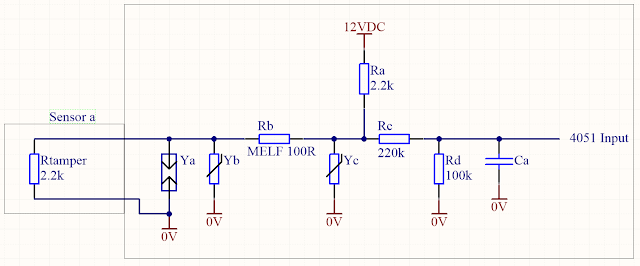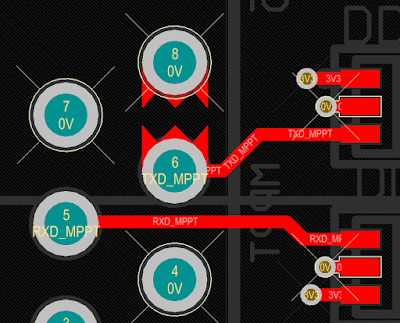This blog is a continuation of a prior blog which illustrated the selection of electronic parts for salvage and basic component removal using a soldering iron.
Salvaging Designs
As used in the first part of the Salvaging Electronic blog, the same NESS security system (D8X D16X) control board will be used for the purposes of this blog. The content of this blog focuses more on salvaging, replicating or repurposing designs. When referring to designs this could be the schematic design, Printed Circuit Board (PCB) layout or both.
The section of Ness control PCB under examination in this blog was the sensor input. This area was chosen was to illustrate the schematic (resistors selection) and PCB design (on-board spark gaps).
The image above shows the passive components related to monitoring devices such as relay contacts (PIR sensors).
A basic schematic representation of one of the input channels is shown below. Note that this hardware design operates in an analogue fashion. That is, the voltage on each sensor input is fed into an analogue switch (4051) and measured by the on-board controller. A break in the line between the externally connected sensor and the sensor input circuit changes the voltage measured.
Of interest in this design is the line facing input resistor (Rb) and the spark gaps (Ya).
How is this design useful?
When designing a product, with similar specifications, then referencing existing and proven designs can serve as a valuable baseline. This is not to say that newer solutions or devices should not be investigated thoroughly. Consider a product with a similar input requirements such as an external automated gate, marine access hatch monitor or cattle feed flow controller which may require external monitoring of a sensor. A similar input circuit would seem a logical choice. Could the input resistor Rb be exchanged with a standard thick film resistor (1206 footprint)?
Looking at a standard Panasonic 1206 resistor, this part is rated at a continuous 200V for a maximum power of 250mW. For steady state conditions this voltage and power handling would be more than suitable. In some systems, inputs can be subject to transient voltages as a result of external events which may be due to indirect lightning strikes for example. Using a single standard thick film resistor may not be the ideal choice for this solution.
Undoubtedly for transient events, additional protection such as Varistors, Transorbs or other surge protection solutions are commonly used in conjunction with suitably rated circuit components. Inputs circuits are usually bolstered using devices designed for handling transients (Pulse Withstanding) such as Metal ELectrode Face (MELF) resistors. MELF devices from Vishay are such an example. The Vishay series MMA HV MELF in an 0204 footprint (1206 compatible), operates at a continuous 300V for a maximum power of 400mW.
For the same footprint and small increase in cost, an input section can be made more robust. This provides the option of switching between standard vanilla and application specific components.
Salvaging Layouts
For the sensor input section, it was mentioned earlier that for transient events other surge protection solutions could be added to the design.
The Ness board has two solutions for line facing transients. One is circuit components (Yb and Yc) and the second is exposed PCB traces (Ya). Components Yb and Yc are most likely Varistors and Ya is an array of several spark gaps made possible by sections of PCB copper with solder mask removed. It should be noted that component Yb is not fitted to the board in lieu of Ya being 'on the fibreglass'. Certainly Varistors are more accurate for a rated breakdown voltage when compared to a spark gap and add cost to the board.
A spark gap, as the name suggests, is a gap or distance between two points across which a transient voltage (spark) can discharge. The distance the spark can breach is a function of creep distance. Technical literature on this subject can be viewed at multiple sites such as EDN Access (basic) - ESD Protection for IO Ports, read on Stack Exchange, Wiley, PTR or the distance needed for a design can be calculated on www.creepage.com. Some understanding of material and contamination of PCB's is required.
For those needing a fundamental understanding of creepage, Paschen's law is a solid starting point.
Focusing on the Ness control PCB, the gap between the two spikes is somewhere around 1mm. Using the tables on the PTR website to determine a ballpark transient overvoltage, for a standard level two PCB contamination on FR4 PCB, yields approximately 400V.
In reality 400V is an extremely low voltage for arcing and only marginally above the theoretical 327V required to arc in one atmosphere of air, see Paschen's law. Regardless of the actual breakdown voltage of this design, some level of protection will be afforded to the design with the addition of spark gaps to the PCB. In any event component, Yc will bear the brunt of any residual voltage that the spark gap does not dissipate.
Adding Spark Gaps to a PCB
Depending on your drafting software of choice, the process to add spark gaps may differ from program to program. The subsequent method described requires only changes to the PCB file however, is not the only method for implementing spark gaps in a PCB design. Some designers may prefer to create the spark gap as a schematic / PCB component library pair or modify existing library components to facilitate the additions of spark gaps. Each method has its own merits and should be reviewed carefully.
The target design for adding spark gaps was the Solar MPPT Project designed in a previous blog. There are two external digital lines which provide communications between an MPPT and a Solar MPPT Controller. These TTL lines expose both the MPPT and Controller to transients and use only steering diodes for protection.
A spark gap separation of 0.5mm was used for the purposes of illustration. For a specific design, the necessary calculations should be made to determine the correct separation.
Fortunately there are ample 0V connections on the existing communication connector. Other designs may need to make use of vias to provide the necessary return path for the transient event.
In the above image, a polygon was added to the solder side of the component - top layer. A single pair of terminals 'points' for the spark gap is sufficient if the chance of the design experiencing a transient event is low. For higher probability of transient events, then more points should be used where practical for the design.
Following the addition of the copper to the board the solder mask must be excluded from the region used by the spark gaps. The capture above shows the spark gaps with the solder mask included.
To exclude the solder mask, a fill was added to cover the area over and between the spark gap terminals.
Viewing the addition of the solder mask fill to the board shows the exclusion over the spark gap terminals. In some instances the PCB terminals are given a liberal coating of solder at the time of assembly. The main goal is to lengthen the lifespan of the terminals.
Whether components, an input design or PCB layout is recovered from the occasional tear down or salvage, the process can be well worth the exercise.
Salvaging Designs
As used in the first part of the Salvaging Electronic blog, the same NESS security system (D8X D16X) control board will be used for the purposes of this blog. The content of this blog focuses more on salvaging, replicating or repurposing designs. When referring to designs this could be the schematic design, Printed Circuit Board (PCB) layout or both.
The section of Ness control PCB under examination in this blog was the sensor input. This area was chosen was to illustrate the schematic (resistors selection) and PCB design (on-board spark gaps).
| Ness Sensor Input Section |
A basic schematic representation of one of the input channels is shown below. Note that this hardware design operates in an analogue fashion. That is, the voltage on each sensor input is fed into an analogue switch (4051) and measured by the on-board controller. A break in the line between the externally connected sensor and the sensor input circuit changes the voltage measured.
Of interest in this design is the line facing input resistor (Rb) and the spark gaps (Ya).
 |
| Sensor Input Section |
When designing a product, with similar specifications, then referencing existing and proven designs can serve as a valuable baseline. This is not to say that newer solutions or devices should not be investigated thoroughly. Consider a product with a similar input requirements such as an external automated gate, marine access hatch monitor or cattle feed flow controller which may require external monitoring of a sensor. A similar input circuit would seem a logical choice. Could the input resistor Rb be exchanged with a standard thick film resistor (1206 footprint)?
Looking at a standard Panasonic 1206 resistor, this part is rated at a continuous 200V for a maximum power of 250mW. For steady state conditions this voltage and power handling would be more than suitable. In some systems, inputs can be subject to transient voltages as a result of external events which may be due to indirect lightning strikes for example. Using a single standard thick film resistor may not be the ideal choice for this solution.
Undoubtedly for transient events, additional protection such as Varistors, Transorbs or other surge protection solutions are commonly used in conjunction with suitably rated circuit components. Inputs circuits are usually bolstered using devices designed for handling transients (Pulse Withstanding) such as Metal ELectrode Face (MELF) resistors. MELF devices from Vishay are such an example. The Vishay series MMA HV MELF in an 0204 footprint (1206 compatible), operates at a continuous 300V for a maximum power of 400mW.
For the same footprint and small increase in cost, an input section can be made more robust. This provides the option of switching between standard vanilla and application specific components.
Salvaging Layouts
For the sensor input section, it was mentioned earlier that for transient events other surge protection solutions could be added to the design.
| Ness Sensor Input Spark Gap |
A spark gap, as the name suggests, is a gap or distance between two points across which a transient voltage (spark) can discharge. The distance the spark can breach is a function of creep distance. Technical literature on this subject can be viewed at multiple sites such as EDN Access (basic) - ESD Protection for IO Ports, read on Stack Exchange, Wiley, PTR or the distance needed for a design can be calculated on www.creepage.com. Some understanding of material and contamination of PCB's is required.
For those needing a fundamental understanding of creepage, Paschen's law is a solid starting point.
Focusing on the Ness control PCB, the gap between the two spikes is somewhere around 1mm. Using the tables on the PTR website to determine a ballpark transient overvoltage, for a standard level two PCB contamination on FR4 PCB, yields approximately 400V.
In reality 400V is an extremely low voltage for arcing and only marginally above the theoretical 327V required to arc in one atmosphere of air, see Paschen's law. Regardless of the actual breakdown voltage of this design, some level of protection will be afforded to the design with the addition of spark gaps to the PCB. In any event component, Yc will bear the brunt of any residual voltage that the spark gap does not dissipate.
Adding Spark Gaps to a PCB
Depending on your drafting software of choice, the process to add spark gaps may differ from program to program. The subsequent method described requires only changes to the PCB file however, is not the only method for implementing spark gaps in a PCB design. Some designers may prefer to create the spark gap as a schematic / PCB component library pair or modify existing library components to facilitate the additions of spark gaps. Each method has its own merits and should be reviewed carefully.
The target design for adding spark gaps was the Solar MPPT Project designed in a previous blog. There are two external digital lines which provide communications between an MPPT and a Solar MPPT Controller. These TTL lines expose both the MPPT and Controller to transients and use only steering diodes for protection.
 |
| Existing Communications Port - No spark gap |
Fortunately there are ample 0V connections on the existing communication connector. Other designs may need to make use of vias to provide the necessary return path for the transient event.
 |
| Top Layer Spark Gap Added |
 |
| Top Side Solder Mask Over Spark Gap |
 |
| Fill Added - Top Layer Solder Mask |
 |
| Top Side Solder Mask Removed Over Spark Gap |
Whether components, an input design or PCB layout is recovered from the occasional tear down or salvage, the process can be well worth the exercise.
